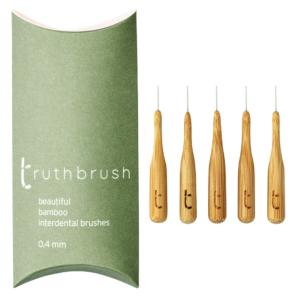Did you know that gum health and hygiene studies show Interdental brushes to be more effective than dental floss in removing plaque and improving gingival health?
These special tools are specially designed to clean between teeth and reach other areas that a regular toothbrush can’t.
Read on to discover:
Wisdom - Lowest Price | TePe - Best Overall | Truthbrush - Best Natural |
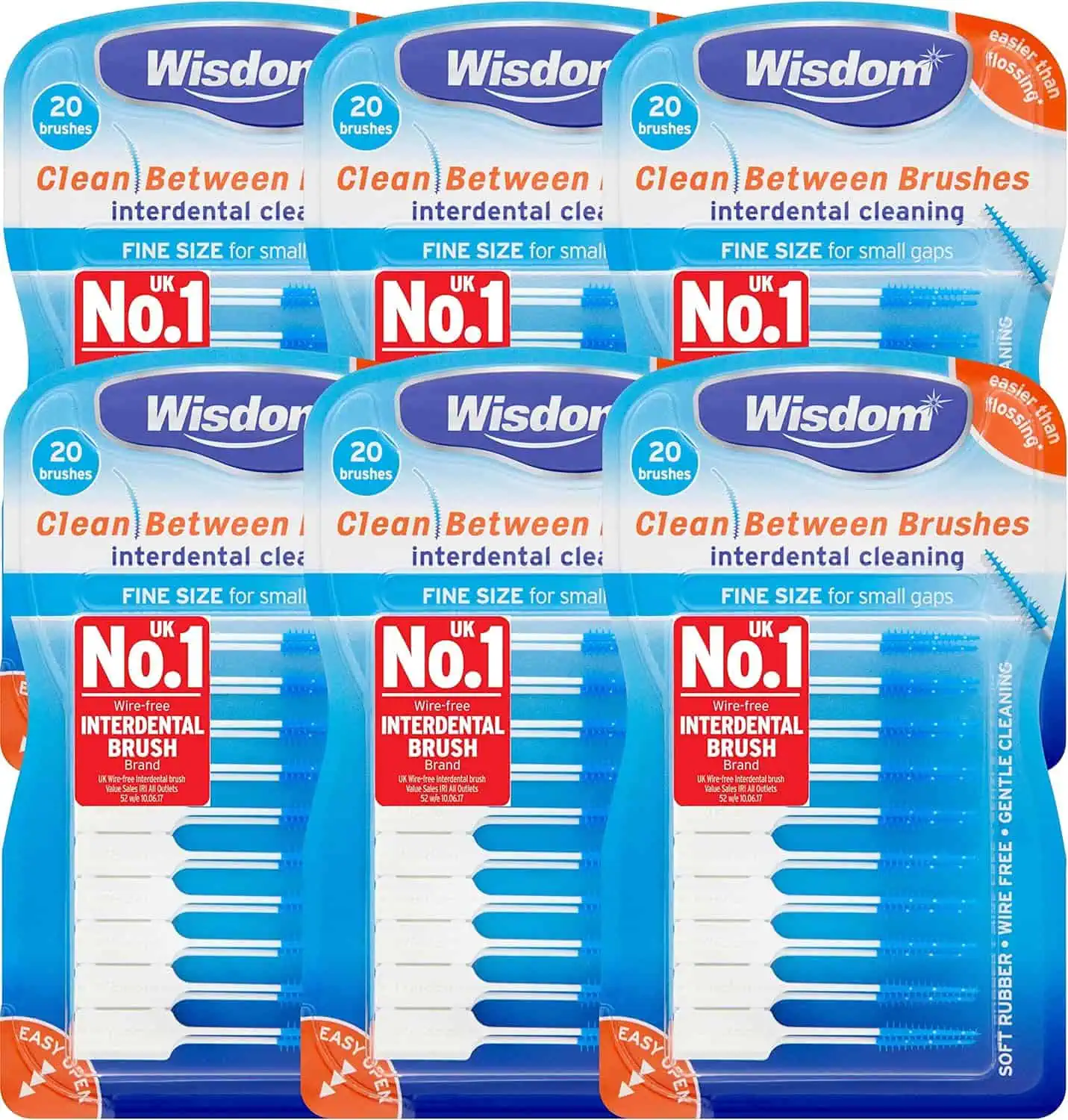 |  | 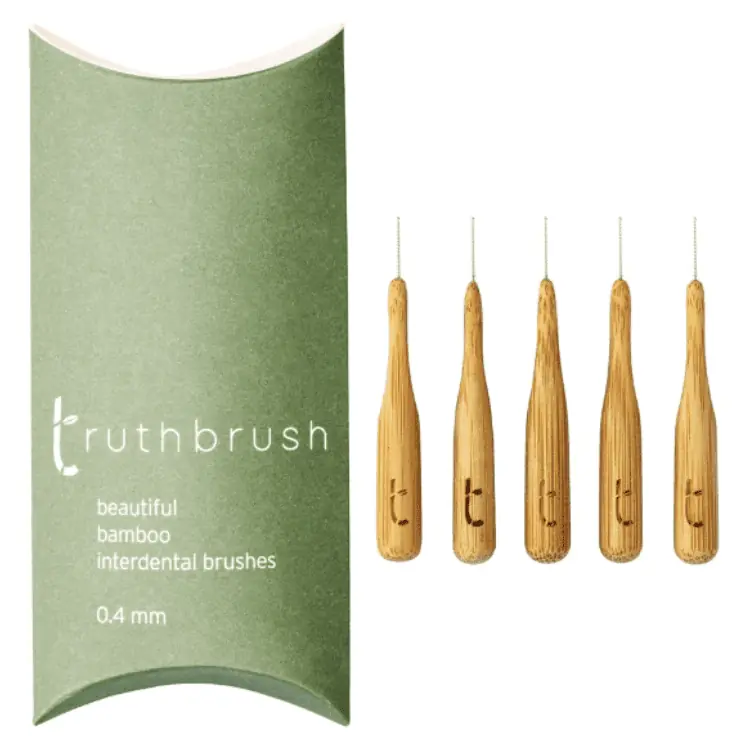 |
In This Article
The best interdental brushes in the UK
So, now you know how to use interdental brushes, but which is the best brand and type for you? Below we cover some of the biggest brands in the UK, as well as some lesser-known ones which offer different features.
TePe interdental brushes
Swedish company TePe is one of the leading names in the specialist toothbrush market. Their wide range of interdental and interspace toothbrushes should suit pretty much every need, whether it’s cleaning a tiny gap between teeth or larger spaces around implants.
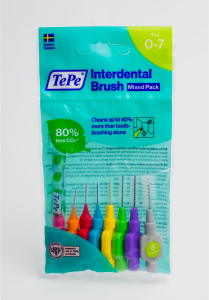
TePe’s regular interproximal brushes come in nine sizes and they also have extra-soft versions in six sizes (0.45, 0.5, 0.6, 0.7, 0.8 and 1.1mm). The four smallest sizes (from 0.4 to 0.6mm) have a flexible neck which provides extra durability.
Tepe Angle interdental brushes have a longer handle, more like a regular toothbrush, with an angled head which is designed to reach in between teeth at the back of the mouth.
You can buy TePe interdental brushes in most high-street chemists, larger supermarkets, and many dental practices. However, you might find the cheapest TePe interdental brushes on Amazon, where you can save by buying in bulk. The pink interdental brushes (pictured) are the smallest available from TePe, but you can browse the full range of sizes by clicking below or select a mixed pack to try out different sizes.
TePe brushes are manufactured to high ISO standards, but one big downside to them is the amount of plastic waste, since no parts of their brushes are re-usable.
Wisdom interdental brushes
Wisdom interdental brush sizes are not as extensive as some other brands; their basic ‘Daily Use’ brush has only two sizes (0.45 and 0.7mm), and their ‘Pro Flex’ brush with a flexible neck comes in four sizes (0.45, 0.6, 0.7 and 0.8mm).
Wisdom also make a range of ‘Clean Between’ rubber interdental brushes. The soft rubber filaments are gentle on gums and safe for use around implants, metal fillings and crowns, and braces. They come in three sizes: fine (blue), medium (green) and large (purple).
Wisdom Clean Between interdental brushes are some of the cheapest available, but judging by user reviews, the low price is reflected in the quality. Some people say they need to use two or three brushes just to get around all their teeth once. So, although they are cheap, they may cost just as much overall as a more expensive brush that lasts a couple of weeks. They are also probably not the right choice if you are environmentally-minded.
Truthbrush interdental brushes
Looking for an environmentally responsible way to clean between your teeth? These specially designed interdental brushes by Truthbrush are carefully made from sustainably sourced bamboo and finished with plant oil for a smooth feel and water resistance.
The ergonomic handle and super soft bristles are perfect for cleaning between teeth. These interdental come in two different sizes, 0.4mm and 0.5mm, and you can buy them in packs of five or bulk buy 20 packs of five.
Truthbrush also offers a subscription service at a discounted price, so you can have new interdental brushes delivered periodically.
Prices are slightly higher than most plastic brushes, as is often the case with environmentally-friendly alternatives, but they are not prohibitively expensive.
Check out our eco toothbrush guide for more bamboo toothbrush options.
CURAPROX interdental brushes
Swiss company CURAPROX brings a more eco-friendly interdental brush to the market. CURAPROX interdental brushes have reusable handles with heads that click into place – a bit like an electric toothbrush. Their CPS Prime brushes have a patented design which makes them ultra fine yet very durable. CURAPROX say that you only need to use a single cleaning movement with their brushes: once in and once out.
Although they are not the cheapest interdental brushes around, the fact you don’t need to use a repeated scrubbing motion means they should last longer – so they may still work out as cost-effective as other brands in the long run.
CURAPROX have a range of straight and angled brushes, as well as special heads for patients with implants, periodontitis, and other particular needs. You can view the full range on Amazon, or get started with this pocket set which contains a long handle and four different sizes of brush head, as well as a handy storage case.
Stoddard ICON interdental brushes
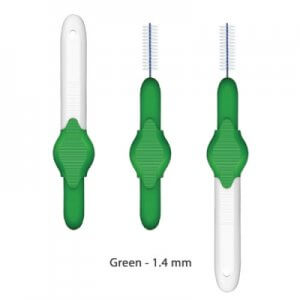
Stoddard interdental brushes are designed and manufactured in the UK. They use a high tensile strength wire to enhance durability, and the protective cap doubles up as an extension to the handle.
The ICON interdental brushes from Stoddard come in a full range of eight sizes, including a white 0.35mm brush which is the smallest of all those we’ve featured here. If you find that other brands of brush are too large to fit between your teeth, this could be worth a try.
Stoddard brushes are used by many dentists in the UK, so you could also check at your local dental surgery to see if they are available to buy there.
The interdental space is the gap between two teeth and there can be food accumulation in this area based on the shape, alignment, and position of your teeth in the mouth.
Interdental aids are devices that can be used for the cleaning of this space. Why do we have to clean this area?
Well, in most cases the saliva in our mouth will do the flushing action of removing debris from this space, but there can be cases where food can get collected in this area such as tooth decay, gum disease resulting in a gum pocket, or overextended fillings.
It is imperative to keep the area clean as our regular toothbrushes will not be able to access this space for cleaning. This is where interdental aids come into the picture and they should form an important part of your oral hygiene regimen.
Healthy spaces make happy faces!
Dr Asha Ramesh
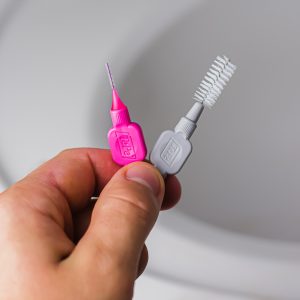
How to use interdental brushes
Once you have selected the correct size brush for the gaps in your teeth, it can take some time to get used to interdental brushing. It might help to stand in front of a mirror at first, until you can do it without looking.
Here are the steps for how to use an interdental brush:
- Make sure you’re using the correct size of brush for each gap.
- Gently press the brush into the space between two teeth, along the gum. Twisting the brush slightly as you insert it can make insertion easier and also extend the life of the brush.
- Brush backwards and forwards several times (unless your dentist instructs you to brush more or you are using a brush which only requires one stroke).
- Carefully remove the brush and move onto the next gap. Change interdental brush sizes as you move around your mouth to ensure you’re using the right size.
If your brush wire breaks or some bristles come loose while you’re using it, discard it and continue with a brand new one.
You can see a practical demonstration of this technique in the following video:
Cleaning between the teeth at the front of the mouth should be quite easy with a regular straight interdental brush. The gaps towards the back of the mouth can be harder to reach, though. There are a few ways you can make access to back teeth easier:
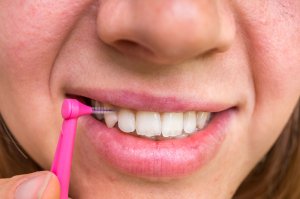
- Try inserting the brush from the inside (next to the tongue or the roof of the mouth) rather than the outside
- Curve the wire slightly around your finger
- Bend the wire at an angle (use a brush with a flexible head to reduce the likelihood of the wire breaking)
- Choose a long-handled interdental brush with an angled head, like the TePe Angle Interdental Brush.
You should use your interdental brush to clean between teeth in this way once a day, while still brushing in the normal way twice a day. See our teeth-brushing guide for more about how to brush your teeth properly.
The best time to clean between your teeth is in the evening. This way, you know that there is no food left between your teeth while you sleep (a common cause of bad morning breath). However, if the morning suits you better, the important thing is that you’re doing it at least once a day.
Should you use interdental brushes before or after brushing?
The Oral Health Foundation recommends interdental cleaning before brushing, based on research which found that doing it this way around removed more plaque overall. Other bodies say that brushing teeth first is just as effective.
Can you reuse interdental brushes?
Yes, absolutely. You only need to change your interdental brush when the bristles start to show signs of wear or the wire gives way. Each brush might last 1-2 weeks or more, depending on how much you use it. Certain manufacturers market their brushes as having better durability, so you might want to try a few and see which lasts longest for you.
If you don’t like the idea of throwing away plastic brushes so often, check out the eco-friendly interdental brush options which we cover later on.
Just like a normal toothbrush, you should rinse interdental brushes after each use to keep them clean.
Should you use toothpaste with interdental toothbrushes?
Unless advised by your dentist, you shouldn’t use toothpaste with an interdental brush. However, you can buy special gels which are suitable for interproximal application, like TePe Gingival Gel. This contains antiseptic chlorhexidine and fluoride to offer extra protection.
Interdental brushes vs floss
You might be wondering whether an interdental brush can replace string floss – especially if you find traditional floss quite difficult to use. Well, the good news is that various studies have shown that using interdental brushes is an effective alternative to flossing. Interproximal brushing can even be more effective at removing plaque than regular flossing, according to this research.
However, you may find that even the smallest interdental brushes are too big to fit between some of the gaps in your teeth. If this is the case, you should still floss those gaps to remove plaque.

If you’re unsure whether to use interdental brushes or floss (or both!), it’s best to ask your dentist. Their answer may depend on your current oral health and the positioning of your teeth, or they might just recommend using whatever you find easier.
Read more about flossing in our guide about how to floss and the best products to use.
Can interdental brushes damage gums?
Used correctly, interdental brushes should clean plaque from the gumline between teeth but shouldn’t cause any damage to the gums. However, it may take a few days to get the hang of it.
Do your gums hurt after using interdental brushes? It’s normal for your gums to bleed a little when you first start using them. This is a sign of early gum disease (gingivitis), but your new cleaning habits will help improve your gum health. Keep up your brushing for a few days, and the bleeding should subside.
If any pain or bleeding continues for more than a week or two, speak to your dentist. You might need a professional teeth cleaning to remove tartar buildup. Or, it may be that you need to try a smaller size or angle the brush differently. Our instructions a little further down will help you avoid damaging your gums by using the wrong technique.
What’s the difference between an interdental and interspace toothbrush?
An interspace toothbrush, or single-tufted toothbrush, is another type of brush designed to reach tricky spots in your mouth. It contains just one small bundle of filaments arranged in a point. Interdental brush filaments stick out to the sides.
Interspace brushes can be useful for cleaning around implants, crowns, bridgework and fixed braces, but they can’t be used for cleaning between teeth. Ask your dentist if you’re unsure which type of brush you should use.
Interdental brush sizes
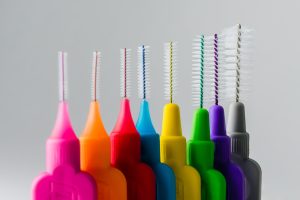
Interproximal toothbrushes come in a range of sizes to suit different needs. The smallest interdental brushes should fit between tightly packed teeth, whereas larger sizes are suitable for cleaning around braces, denture implants, and gaps left by missing teeth.
Interproximal brush size guide
Manufacturers colour-code their brushes to make it easy to tell different sizes apart. Unfortunately, they don’t all use the same colours for each size. For instance, a 1.1mm purple interdental brush from TePe corresponds to a green one from CURAPROX. So if you are switching between brands, make sure you check the size of your brush rather than just the colour.
In the table below you can see the sizes offered by some of the main manufacturers and the corresponding colours. There is an ISO sizing standard which numbers brushes from 0 to 8, but not all manufacturers use this.
ISO size | Wire Size (mm) | TePe | CURAPROX Prime | Wisdom | Stoddard ICON |
0.35 | White | ||||
0 | 0.4 | Pink | Pink | ||
1 | 0.45 | Orange | Orange | Orange | |
2 | 0.5 | Red | Red | ||
3 | 0.6 | Blue | Blue | Blue | Blue |
4 | 0.7 | Yellow | Red | Yellow | Yellow |
5 | 0.8 | Green | Pink | Green | Green |
0.9 | Yellow | ||||
6 | 1.1 | Purple | Green | Purple | |
7 | 1.3 | Grey | Grey | ||
8 | 1.5 | Black |
As you can see, Stoddard and TePe interdental brush sizes offer the most variety, whereas other brands focus on the mid-range sizes. The smallest interdental brush featured here is the white 0.35mm one from Stoddard, which you can buy on Amazon here.
Choosing the right sized brush
It’s important to choose the right size for each of the spaces you need to clean. Too small, and the brush may not clean effectively. Too large, and you risk damaging your teeth or gums in the process. Of course, this may mean you need to use a number of different sized brushes to perform a complete teeth cleaning.
The brush should fit comfortably into the gap between your teeth. Inserting it should only require slight pressure. If it feels like you’re forcing it, stop and try a smaller size.
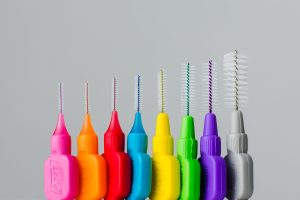
Your dentist will be able to measure the spaces between your teeth and advise you of the interdental brush size(s) you should use. But if you want to know what size interdental brush to use without visiting a dentist, try purchasing a multipack with a variety of different sizes.
This mixed pack of TePe interdental brushes has one of each size from 0 to 7 (0.4mm to 1.3mm). Buying this is a very cost-effective way to work out which sizes you need before buying larger quantities of each.
If you prefer an angled brush (more on these below) then you can buy this pack of 6 from TePe with all six sizes from 0 to 5.
Conclusion
Cleaning between teeth is an important part of your daily oral hygiene routine. Interdental brushes are an effective alternative to string floss, and they are available in different sizes to suit any kind of space between teeth.
When choosing the best interdental brush for you, consider the following:
- Are you prepared to pay more for a higher-quality, durable brush that will last longer?
- Do you need a long-handled brush with an angled head for reaching your back teeth?
- Do you need brushes in a variety of sizes for cleaning different-sized gaps?
- Would you prefer a less wasteful option like a bamboo-handled brush or a water flosser?
We hope the information in this guide has helped you understand interdental brush sizes and designs so you can select one that meets your needs.
ResearchGate: Comparison Between Interdental Brush and Dental Floss for Controlling Interproximal Biofilm in Teeth and Implants. Consulted 23rd September 2019.
Oral Health Foundation: Which comes first, brushing or flossing? New study shows that we should clean between our teeth before brushing. Consulted 23rd September 2019.





